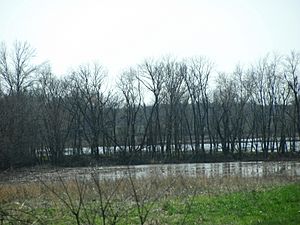Lakeview, Illinois facts for kids
Quick facts for kids
Lakeview
|
|
|---|---|

Map of Lakeview circa 1908.
|
|
| Nickname(s):
Pond Settlement
|
|
| Country | United States |
| State | Illinois |
| County | Saline |
| Founded | 1818–1820 |
| Time zone | UTC-6 (CST) |
| • Summer (DST) | UTC-5 (CDT) |
| Area code(s) | 618 |
Lakeview is a small community in Saline County, Illinois, United States. It is an "unincorporated community," meaning it doesn't have its own local government like a city or town. Lakeview is mostly made up of African American families.
This community was first called "Pond Settlement." It got this name because of the many Cypress swamps and wetlands around Carrier Mills, Illinois. Lakeview is one of the oldest settlements in Illinois. It also has the oldest African American cemetery in the state.
Contents
Discovering Lakeview's Beginnings
Lakeview is thought to be the oldest community in Illinois founded by both runaway slaves and Freed men. These were people who had escaped slavery or were no longer enslaved.
How Lakeview Was Founded
Lakeview was started by a group of African American runaway slaves and freedmen. They came from North Carolina between 1818 and 1820. This was soon after the War of 1812.
The area was perfect for Native American families who lived there before. They hunted, fished, and farmed the land. Around 1800, many Native American families got Small Pox. This disease sadly wiped out most of them. Only a few families remained. They welcomed the new freedmen settlers.

The First Families of Lakeview
Early records show that the Allen, Blackwell, Taborn, Mitchell, Evans, Cofield, and Cole families were the first settlers. These families were mostly self-sufficient. They found their own food by hunting and farming.
Before the American Civil War, these families owned a lot of land. Some of this land was sold later when the village of Morrillsville, now Carrier Mills, Illinois, was built. Over time, more land was sold, and the larger land holdings became smaller.
Life in the Lakeview Community
Lakeview was never a formal town or village. It was a group of farmsteads spread over about 3 square miles (8 km²). The main gathering places were always the church and the school. These were located along what is now Taborn Road.
Schools and Churches
Lakeview had its own school and a grocery store. Many homes were also there. In 1850, a Union Church was started near Carrier Mills. Most of its members were Baptist or Methodist.
An African Methodist Episcopal (AME) Church was also formed. It began in Irvin Allen's home. He then built a small log church on his land. Later, a new church building was constructed on the M. Taylor farm. After that church burned down, they rebuilt it in Carrier Mills. This church is now called Baber Chapel AME Church.
The Lakeview Cemetery
The Lakeview cemetery was founded in 1838. It is now a state historical landmark. The Lakeview area is still almost entirely African American. After the Lakeview school closed in the 1950s, many people moved to the east side of Carrier Mills.
Descendants of the original Lakeview families still hold a reunion every year. This gathering takes place at the cemetery on Memorial Day. This tradition has continued for many decades, starting in the 1800s.
Remembering a Local Hero
Deputy Royce E. Cline was a police officer in Saline County, Illinois. He was the only officer in the county to die while on duty. This happened on Friday, August 14, 1925, in the "pond settlement" area. He was investigating a crime when he died.
Preserving Lakeview's Heritage
Efforts are being made to recognize Lakeview's important history.
Seeking Historical Recognition
In 2022, Brendan Jennings, a descendant of Lakeview families, applied for a federal historical designation. This would officially recognize Lakeview as a historic district. The Saline County Tourism Board created a committee to help with this project.
Grants for African American Heritage
In 2023, the Illinois Department of Natural Resources (IDNR) received a grant. It was for $75,000 from the National Park Service. This money will help recognize important African American heritage sites in southern Illinois.
This project is a team effort. It involves the Illinois State Historic Preservation Office and Southern Illinois University. They will work to get three Black history sites listed on the National Register. The project will also update existing listings, like the Carrier Mills Archaeological District. This will highlight the African American heritage of the Pond Settlement, also known as Lakeview.





